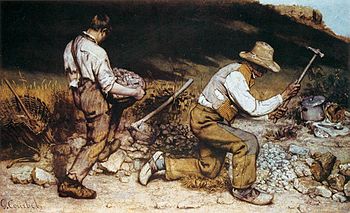Maruyama Ōkyo, “Crows” (1766)
What’s comes into your mind if you hear about realism? It might be Gustave Courbet’s The Stone Breakers or Ilya Repin’s Barge Haulers on the Volga. Realism usually depicts laborers and ordinary people in everyday life situations. Realist painters paint in a naturalistic manner and even in a photographic way. That’s why realism is sometimes related to naturalism. Naturalism was an art movement in the nineteenth century which emphasized the representation of things that close to reality.
Gustave Courbet, “The Stone Breakers”, 1849
Besides the general view of Realism, I will turn to an interesting view of Realism by Nelson Goodman. According to Goodman, Realism “depends upon familiarity; the pictures in the accustomed, standard mode of representation count as the more realistic.” (Goodman, 1984:127). A realistic picture can include inaccuracies but remain appears realistic, for example in games “Find five or fifteen mistakes in the picture”.
Goodman’s point of view opens to other ‘realism’ from across different cultures. Every culture has a “familiar” or “standard” representation that has been acknowledged as a realistic representation.
For instance, Realism in Japanese in the 18th century. Maruyama Ōkyo (1733-1795) was a Japanese painter who was well known for his realistic picture. His realistic depiction of animals, human figures, and landscapes was based on the observation of the natural world.
Ōkyo synthesizes traditional Japanese style with the western-naturalism. He established an art school in Kyoto, which is called Maruyama school. In this school, he transmitted his realistic painting techniques of light, shadow, and forms to his students.
Yosa Buson and Ike no Taiga were called as a renewed search of the Ōkyo’s realism. Buson and Taiga collaborated to create an album Ten Conveniences and Ten Pleasures (1771). This album contained a depiction of nature and anecdotal style of human activities. They combined painting with a Japanese linked-verse form that is called haikai no renga.
Ilya Repin, ” Barge Haulers on the Volga” (1870)
Goodman’s view on Realism opens to a richer meaning of realism. Realism is shared in many different cultures in various styles, as exemplified by Ōkyo, Buson’s, and Taiga’s paintings.


